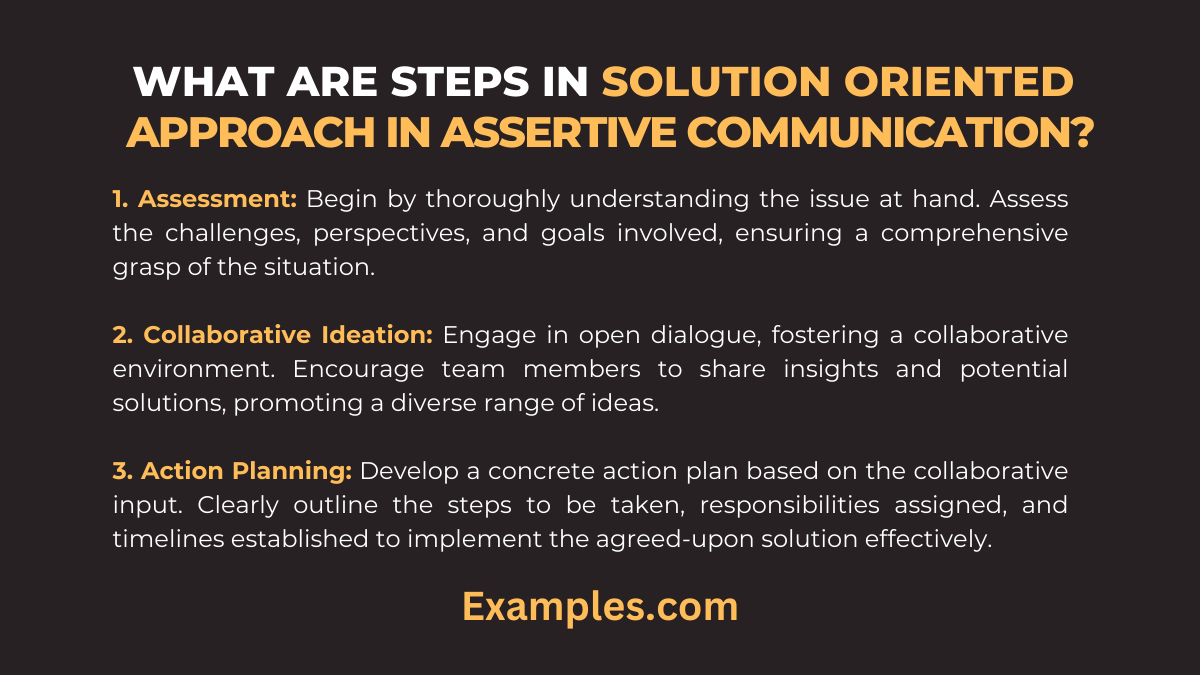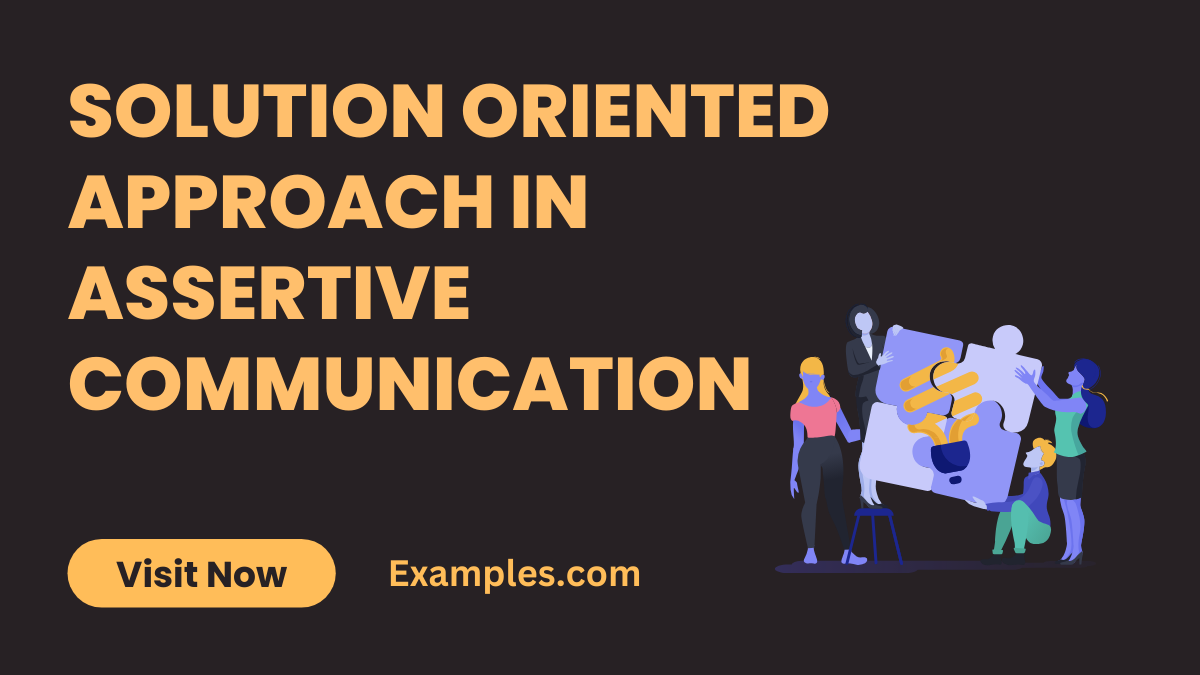19+ Solution Oriented Approach In Assertive Communication Examples
Unlock the keys to effective communication with a Solution-Oriented Approach. This guide provides insights into navigating conflicts, fostering collaboration, and achieving positive outcomes through assertive communication strategies. Dive into real-world examples that showcase the power of this approach in resolving issues and building strong interpersonal connections.
What is Solution Oriented Approach In Assertive Communication?

A Solution-Oriented Approach in assertive communication emphasizes proactive problem-solving. It involves addressing conflicts with a focus on finding mutually beneficial solutions, promoting understanding, and maintaining positive relationships. This approach encourages individuals to actively contribute to resolution strategies, fostering a constructive and collaborative environment.
20 Solution Oriented Approach In Assertive Communication Examples

Unlock the potential of assertive communication with a solution-oriented mindset. These examples demonstrate how to navigate conflicts, promote collaboration, and achieve positive results through proactive problem-solving.
- Collaborative Project Planning: Embrace a solution-oriented approach by actively involving team members in project planning. Say, “Let’s collaboratively design a project timeline that accommodates everyone’s priorities.”
- Resource Allocation Dilemma: In addressing resource conflicts, assertively propose solutions like, “I recognize the constraints; let’s redistribute resources for optimal project success.”
- Innovation Implementation Discussion: Navigate tech discussions with a solution-oriented mindset. State, “I understand the innovation; let’s assess modifications for a smoother integration.”
- Budgetary Decisions Debate: Express disagreement with a budget proposal by suggesting, “I appreciate the budget; let’s reallocate funds for more impactful initiatives.”
- Teamwork Dynamics Challenge: Address team dynamics with assertive communication, saying, “I see your point; let’s explore a collaborative approach considering everyone’s strengths.”
- Training Program Enhancement: Assertively disagree on training programs by suggesting, “I value the program; let’s consider additional modules for a holistic approach.”
- Product Feature Prioritization: Express disagreement on feature priorities, stating, “I acknowledge chosen features; let’s reconsider based on user feedback for optimal satisfaction.”
- Organizational Restructuring Conversation: Navigate restructuring discussions by expressing, “I understand the changes; let’s evaluate alternatives for minimal disruption.”
- Content Marketing Strategy Disagreement: Assertively disagree on content strategies, saying, “I value the strategy; let’s tweak it for increased audience engagement.”
- Client Communication Enhancement: Disagree on client communication methods, stating, “I appreciate the current approach; let’s explore more personalized methods for stronger client relationships.”
- Performance Evaluation Criteria Discussion: Express disagreement on evaluation criteria, saying, “I understand the criteria; let’s consider additional factors for a comprehensive evaluation.”
- Corporate Social Responsibility Alignment: Disagree on CSR initiatives by suggesting, “I acknowledge proposed initiatives; let’s explore partnerships for a broader impact.”
- Company Values Realignment: Express disagreement on values, stating, “I respect our principles; let’s refine them to better align with our evolving organizational culture.”
- Project Strategy Enhancement: Assertively disagree in team discussions by proposing, “I see your perspective; let’s propose an alternative approach for greater efficiency.”
- Creative Ideation Modification: Express disagreement during brainstorming by suggesting, “I appreciate your idea; however, I propose a modification for better alignment with our goals.”
- Policy Implementation Adjustment: Disagree respectfully on organizational decisions, affirming, “I understand the rationale; let’s consider a different policy for better outcomes.”
- Timeline Adjustment Proposal: Assertively disagree on project timelines by suggesting, “I acknowledge the urgency; let’s consider a more realistic timeframe for quality delivery.”
- Marketing Strategy Tweaking: Disagree during campaign planning, stating, “I value the strategy; however, I suggest incorporating additional elements for a more comprehensive approach.”
- Language Learning Program Customization: Express disagreement on language study methods, saying, “I appreciate your approach; let’s tailor our methods for better language comprehension.”
- Quizlet Feature Reassessment: Assertively disagree on Quizlet features, stating, “I acknowledge proposed features; let’s prioritize based on user feedback for optimal satisfaction.”
Solution Oriented Approach In Assertive Communication Examples For Student with Disabilities
Navigate communication challenges with a solution-oriented approach, fostering inclusivity for students with disabilities. These examples demonstrate empathetic and assertive strategies, ensuring a positive and supportive learning environment.
- Individualized Accommodations Request: Address a student’s needs by saying, “I recognize your requirements; let’s collaborate to create individualized accommodations for optimal learning.”
- Accessible Learning Materials: Propose accessible materials by stating, “I value your learning style; let’s work on adapting materials to ensure a more inclusive educational experience.”
- Effective Communication Preferences: Explore communication preferences with, “I respect your preferences; let’s establish effective communication methods that cater to your needs.”
- Collaborative Classroom Modifications: Engage in dialogue with, “I acknowledge your concerns; let’s collaboratively assess and implement classroom modifications for a conducive learning environment.”
- Empowering Self-Advocacy Skills: Encourage self-advocacy by saying, “I see your potential; let’s empower you with skills to effectively communicate your needs within the academic setting.”
- Peer Understanding Initiative: Foster peer understanding by suggesting, “I appreciate your uniqueness; let’s initiate awareness programs to promote understanding and acceptance among peers.”
- Adaptive Technology Integration: Propose adaptive technologies with, “I understand your challenges; let’s explore integrating adaptive tools to enhance your learning experience.”
- Feedback Collaboration Session: Schedule collaborative feedback sessions with, “I value your input; let’s work together to ensure feedback is constructive and supports your learning goals.”
- Inclusive Group Activities: Plan inclusive group activities, stating, “I acknowledge your interests; let’s design activities that foster collaboration and ensure the involvement of all students.”
- Interactive Learning Platforms: Explore interactive learning platforms with, “I recognize your preferences; let’s identify and incorporate digital platforms that enhance your engagement and participation.”
Solution Oriented Approach In Assertive Communication Examples for Manager
Empower effective leadership through assertive and solution-oriented communication. These examples guide managers in navigating challenges, fostering teamwork, and achieving positive outcomes in the workplace.
- Feedback Enhancement Proposal: Suggest a feedback enhancement with, “I value feedback; let’s introduce a system that encourages regular, constructive feedback for professional growth.”
- Conflict Resolution Workshop: Propose a conflict resolution workshop by stating, “I understand workplace dynamics; let’s organize a workshop to equip teams with effective conflict resolution skills.”
- Team Productivity Analysis: Assess team productivity with, “I acknowledge challenges; let’s collaboratively analyze workflows to identify and implement strategies for enhanced efficiency.”
- Flexible Work Arrangements: Discuss flexible work arrangements with, “I value work-life balance; let’s explore flexible schedules that accommodate employees’ personal and professional needs.”
- Skill Development Initiatives: Encourage skill development by saying, “I see potential; let’s invest in training programs that empower employees to enhance their professional skills.”
- Diversity and Inclusion Initiatives: Propose diversity and inclusion initiatives with, “I value diversity; let’s implement programs that foster an inclusive workplace and celebrate diverse perspectives.”
- Performance Improvement Plan: Implement a performance improvement plan by stating, “I recognize areas for growth; let’s collaboratively develop a plan to support and elevate team members.”
- Transparent Communication Strategy: Establish transparent communication strategies with, “I value open communication; let’s ensure regular updates and transparent information flow for an informed team.”
- Recognition Program Implementation: Introduce a recognition program by saying, “I appreciate hard work; let’s implement a program to acknowledge and celebrate employees’ achievements.”
- Mental Health Support Policies: Advocate for mental health support policies with, “I understand well-being concerns; let’s implement policies that support employees’ mental health and create a supportive work environment.”
What are Steps of Solution Oriented Approach In Assertive Communication?

Embrace a solution-oriented approach in assertive communication with these steps:
- Assessment: Begin by thoroughly understanding the issue at hand. Assess the challenges, perspectives, and goals involved, ensuring a comprehensive grasp of the situation.
- Collaborative Ideation: Engage in open dialogue, fostering a collaborative environment. Encourage team members to share insights and potential solutions, promoting a diverse range of ideas.
- Action Planning: Develop a concrete action plan based on the collaborative input. Clearly outline the steps to be taken, responsibilities assigned, and timelines established to implement the agreed-upon solution effectively.
Tips and Benefits for Effective Solution Oriented Approach In Assertive Communications
Adopting a solution-oriented approach in assertive communication fosters positive outcomes. Follow these steps to enhance your communication style:
- Identify Core Issues: Pinpoint key challenges in discussions to focus on solutions.
- Emphasize Collaboration: Encourage teamwork by involving all parties in the solution-seeking process.
- Stay Future-Focused: Orient discussions toward constructive future actions rather than dwelling on past issues.
- Validate Perspectives: Acknowledge diverse viewpoints to create an inclusive problem-solving environment.
- Communicate Clear Expectations: Set clear expectations for outcomes to guide the discussion towards specific solutions.
Benefits:
- Strengthened relationships through collaborative problem-solving.
- Enhanced team morale with a focus on constructive actions.
- Improved workplace efficiency with solutions tailored to specific challenges.
- Reduced conflicts as discussions center around actionable solutions.
- Fostered innovation and creativity by encouraging diverse perspectives in problem-solving.
Embracing a solution-oriented approach in assertive communication is crucial for developing healthy, productive relationships and environments, whether in personal life, the workplace, or educational settings. This approach, centered around proactive problem-solving and mutual respect, not only resolves conflicts effectively but also strengthens interpersonal bonds. By focusing on solutions rather than problems, individuals and groups can navigate challenging situations with greater ease, fostering a positive and collaborative atmosphere. The ability to approach conflicts with a solution-focused mindset is invaluable in today’s diverse and dynamic world.
For those interested in expanding their knowledge and skills in this area, the University of California, Berkeley’s Greater Good Science Center offers a wealth of resources on positive psychology and effective communication techniques. Additionally, the American Management Association provides in-depth training and resources on assertive communication and conflict resolution strategies in professional settings. These resources offer valuable insights and practical tools to enhance one’s ability to communicate assertively and focus on solutions.



